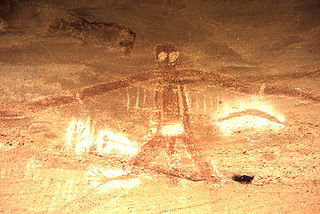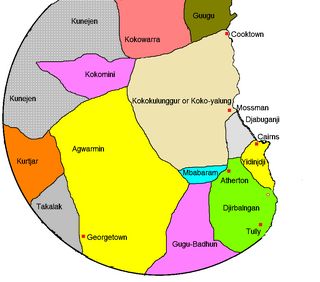Related Research Articles

Mabo v Queensland is a landmark decision of the High Court of Australia that recognised the existence of Native Title in Australia. It was brought by Eddie Mabo against the State of Queensland and decided on 3 June 1992. The case is notable for being the first in Australia to recognise pre-colonial land interests of Indigenous Australians within the common law of Australia.
Native title refers to rights, recognised by Australian law, held by Aboriginal and Torres Strait Islander groups or individuals to land that derive from their maintenance of their traditional laws and customs. These Aboriginal title rights were first recognised as a part of Australian common law with the decision of Mabo v Queensland in 1992. The doctrine was subsequently implemented and modified via statute with the Native Title Act 1993.
The Office of the Registrar of Indigenous Corporations (ORIC) assists the Registrar of Indigenous Corporations in administering the Corporations Act 2006 and in supporting and regulating corporations for Indigenous people throughout Australia. The CATSI Act is similar to the Corporations Act 2001.

The Native Title Act 1993(Cth) is a law passed by the Australian Parliament, the purpose of which is "to provide a national system for the recognition and protection of native title and for its co-existence with the national land management system". The Act was passed by the Keating government following the High Court's decision in Mabo v Queensland (No 2) (1992). The Act commenced operation on 1 January 1994.

Badu or Badu Island, is an island in the Torres Strait 60 kilometres (37 mi) north of Thursday Island, Queensland, Australia. Badu Island is also a locality in the Torres Strait Island Region, and Wakaid is the only town, located on the south-east coast. This island is one of the Torres Strait Islands. The language of Badu is Kala Lagaw Ya.
The Jidi Jidi Aboriginal Corporation is an RNTBC created in accordance with the Native Title Act 1993, to manage and be trustee of the Native Title of the Nharnuwangga Wajarri Ngarlawangga People, a group of Aboriginal Australian peoples in the Pilbara region of Western Australia.
The Bwgcolman is the self-assigned name for the Aboriginal Australians who were deported from many areas of the Queensland mainland, and confined in resettlement on Great Palm Island after the establishment of an Aboriginal reserve there in 1918, the Palm Island Aboriginal Settlement, and their descendants today. The name has also sometimes been applied to the island itself.

An Australian Aboriginal sacred site is a place deemed significant and meaningful by Aboriginal Australians based on their beliefs. It may include any feature in the landscape, and in coastal areas, these may lie underwater. The site's status is derived from an association with some aspect of social and cultural tradition, which is related to ancestral beings, collectively known as Dreamtime, who created both physical and social aspects of the world. The site may have its access restricted based on gender, clan or other Aboriginal grouping, or other factors.
Australian heritage laws exist at the national (Commonwealth) level, and at each of Australian Capital Territory, New South Wales, Northern Territory, Queensland, South Australia, Tasmania, Victoria, Western Australia state and territory levels. Generally there are separate laws governing Aboriginal cultural heritage and sacred sites, and historical heritage. State laws also allow heritage to be protected through local government regulations, such as planning schemes, as well.

An Indigenous Protected Area (IPA) is a class of protected area used in Australia; each is formed by voluntary agreement with Indigenous Australians, and declared by Aboriginal Australians and Torres Strait Islander representative organisations. Each is formally recognised by the Australian Government as being part of its National Reserve System. The areas may comprise land and sea, and are managed by Indigenous groups for the conservation of biodiversity. Managing IPAs also helps to protect the cultural values of their country for future generations, and has benefits for Indigenous health, education, economic and social cohesion.
Land councils, also known as Aboriginal land councils, or land and sea councils, are Australian community organisations, generally organised by region, that are commonly formed to represent the Indigenous Australians who occupied their particular region before the arrival of European settlers. They have historically advocated for recognition of traditional land rights, and also for the rights of Indigenous people in other areas such as equal wages and adequate housing. Land councils are self-supporting, and not funded by state or federal taxes.
A Registered Native Title Body Corporate (RNTBC) is a corporation nominated by a group of Aboriginal or Torres Strait Islander people for the purposes of native title in Australia, to represent their native title rights and interests, once that group's native title application has been recognised in a Federal Court of Australia determination, and the corporate body registered. The corporation nominated hold and manage or manage before native title determination and registration, is called a Prescribed Body Corporate (PBC).
Indigenous land rights in Australia, also known as Aboriginal land rights in Australia, are the rights and interests in land of Aboriginal and Torres Strait Islander people in Australia; the term may also include the struggle for those rights. Connection to the land and waters is vital in Australian Aboriginal culture and to that of Torres Strait Islander people, and there has been a long battle to gain legal and moral recognition of ownership of the lands and waters occupied by the many peoples prior to colonisation of Australia starting in 1788, and the annexation of the Torres Strait Islands by the colony of Queensland in the 1870s.

Wamin, also known as Agwamin or Ewamian, is an Australian Aboriginal language of North Queensland spoken by the Ewamian people. Wamin was traditionally spoken in the Etheridge region, in the areas around Einasliegh, Georgetown, and Mount Surprise.
In Australia, an Aboriginal land trust (ALT) is a type of non-profit organisation that holds the freehold title to an area of land on behalf of a community of Aboriginal Australians. The land has been legally granted to a community by the government under a perpetual lease, usually after the community makes a formal claim of traditional ownership. Land granted under Aboriginal title is inalienable; it can not be bought, sold, traded or given away. The land trust is the organisation appointed by the community to legally hold the title deeds. The land trusts are administered by Aboriginal land councils.

A Registered Aboriginal Party (RAP) is a recognised representative body of an Aboriginal Australian people per the Aboriginal Heritage Act 2006 (Vic.), whose function is to protect and manage the Aboriginal cultural heritage in the state of Victoria in Australia.
The South West Aboriginal Land and Sea Council (SWALSC) is the organisation that represents the Noongar people, the Aboriginal Australians of the southwest corner of Western Australia. It was formed in 2001, and is incorporated under the Corporations Act 2006. The Council's primary role is to assist the Noongar people with native title claims and Indigenous land use agreements. It also helps support Noongar culture and heritage, and publishes the Kaartdijin Noongar website.

The Gugu Badhun are an Aboriginal nation whose country is located in the Upper Burdekin region of northern Queensland. Gugu Badhun country is approximately 220 km northwest of Townsville and includes the small township of Greenvale as well as a number of pastoral stations. The most comprehensive and up-to-date description of the nation is found in the book Gugu Badhun: People of the Valley of Lagoons, published in 2017.
The Kokatha, also known as the Kokatha Mula, are an Aboriginal Australian people of the state of South Australia. They speak the Kokatha language, close to or a dialect of the Western Desert language.
Constitutional recognition of Indigenous Australians refers to various proposals for changes to the Australian Constitution to recognise Indigenous Australians in the document. Various proposals have been suggested to symbolically recognise the special place Indigenous Australians have as the first peoples of Australia, along with substantial changes, such as prohibitions on racial discrimination, the protection of languages and the addition of new institutions. In 2017, the Uluru Statement from the Heart was released by Indigenous leaders, which called for the establishment of an Indigenous Voice to Parliament as their preferred form of recognition. When submitted to a national referendum in 2023 by the Albanese government, the proposal was heavily defeated.
References
- 1 2 "Tribunal's role". National Native Title Tribunal. Retrieved 22 July 2020.
 Text was copied from this source, which is available under a Attribution 4.0 International (CC BY 4.0) licence (as per this page).
Text was copied from this source, which is available under a Attribution 4.0 International (CC BY 4.0) licence (as per this page). - 1 2 "Planning, service and satisfaction". National Native Title Tribunal. Retrieved 22 July 2020.
 Text was copied from this source, which is available under a Attribution 4.0 International (CC BY 4.0) licence (as per this page).
Text was copied from this source, which is available under a Attribution 4.0 International (CC BY 4.0) licence (as per this page). - ↑ "RNTBCs". Office of the Registrar of Indigenous Corporations. 2015. Retrieved 14 May 2021.
- ↑ "Land and Housing". National Indigenous Australians Agency . Retrieved 14 May 2021. Published under a Attribution 4.0 International (CC BY 4.0) licence (as per this page)
- ↑ "RATSIB Areas". data.gov.au. Australian Government. Retrieved 14 May 2021.
 Text may have been copied from this source, which is available under a Attribution 3.0 Australia (CC BY 3.0 AU) licence. See here.
Text may have been copied from this source, which is available under a Attribution 3.0 Australia (CC BY 3.0 AU) licence. See here. - 1 2 Map of NTRBs and NTSPs around Australia (PDF) (Map). NNTT.
- ↑ "Native title representative bodies and service providers". National Indigenous Australians Agency . Retrieved 14 May 2021.
 Text was copied from this source, which is available under a Attribution 4.0 International (CC BY 4.0).
Text was copied from this source, which is available under a Attribution 4.0 International (CC BY 4.0).